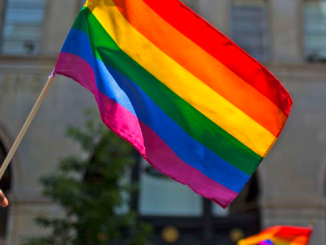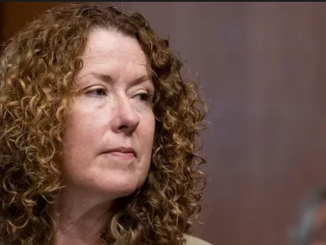
Although she is 70 years old, Theresa Byrd can still feel the sting of growing up Black in Liberty — forced in the era of legal segregation to walk away from the white elementary school just blocks from her home to the Black Garrison School nearly a mile away.
“In my route, “ Byrd recalled, “I went up through town and frequently I was ridiculed, or relegated off the sidewalk, told to get in the street, called the N-word, was spat at.”
A statue always loomed nearby:
At some 20 feet tall, it is a granite likeness of a Confederate soldier, atop a Confederate flag in relief, that some argue is a sacred and historic grave marker. But Byrd and a small cadre of others insist it is so abhorrent they are now willing to give $10,000 to the city to help remove it from the public Fairview & New Hope Cemeteries, where it has stood for 117 years.
“My intent is to be buried in the Fairview cemetery,” said Byrd, who works as the deputy court administrator of Jackson County’s Family Court. At least 50 of her relatives are buried in what began as a segregated portion of the cemetery.
“I pray, I ask God, before that day comes, for that monument to be gone, that it will not be lording over that cemetery when I am laid to rest there. … It is painful. It is an abomination.”
But those who defend the statue, surrounded by the unmarked graves of what may be as many as 40 Confederate veterans, insist it is going nowhere.
“We’re not going to voluntarily destroy our own markers and monuments. That’s what they’re asking us to do,” said Larry Yeatman of Clay County, an insurance agent and member of a local chapter of Sons of Confederate Veterans whose predecessor group, the United Confederate Veterans, erected the monument in 1904 on a plot purchased using donations.
The cemetery is public, owned by Liberty, a city in which about 1,200 or 4% of its 30,000 residents are Black. The plot is private. Defenders argue that, as such, they have the right to leave the monument where it is. Confederate monuments stand in six Kansas City area public and private cemeteries.
“It’s staying,” Liberty resident Gieselle Fest said of the soldier, facing east with his rifle at rest.
Fest, along with the Sons of Confederate Veterans, has been fighting to keep the statue ever since a change.org petition in June began collecting signatures to have it taken down. She began a counter petition and a “Save Our Monument” Facebook page.
“If it was on the courthouse yard, if it was in the middle of city hall, if it was being taken care of by the taxpayer money, then it would be a different conversation,” Fest said. “This is a cemetery. It is a grave marker. If you start to take down a cemetery marker, a grave marker, where do you stop?”
Impetus to remove monuments
The issue of whether Confederate monuments or flags should remain in public spaces has been igniting fierce debate since at least 2015, after white gunman Dylann Roof killed nine Black churchgoers in Charleston, South Carolina. Roof, an avowed racist, pleaded guilty and currently sits on death row in federal prison.
He kept photographs of himself at Confederate and Black historic sites holding the Confederate flag and the weapon he used in his murders. In response, South Carolina’s lawmakers ordered the Confederate flag to be removed from the statehouse grounds.
Then in August 2017, thousands of people allied with neo-Nazis, neo-Confederates, Klansmen and other white supremacists gathered in Charlottesville, Virginia, for a “Unite the Right” rally to protest a city proposal to raze a statue of Confederate Gen. Robert E. Lee. One woman was killed at the protest, and the statue still stands.
Days later in Kansas City, a memorial to the “Loyal Women of the Old South” on public property on Ward Parkway became the target of vandals, and the city soon removed it permanently.
George Floyd’s killing in May by a white police officer in Minneapolis again reignited demonstrations over public symbols of racism, slavery or oppression. Monuments have since fallen nationwide.
In Kansas City in June, developer J.C. Nichols’ name was stripped from a fountain and road at the Country Club Plaza because of his racist housing policies. The Kansas City City Council continues to consider renaming roads named for former slaveholders.
The Jackson County Legislature left it up to voters to decide whether to remove statues of namesake Andrew Jackson from the county’s two courthouses because of his role in the subjugation and death of thousands of Native Americans. In November, nearly 60% of voters opted to keep the statues.
But removal of the monument in Liberty, as well as a similar one towering over Forest Hill & Calvary Cemetery off Troost Avenue in Kansas City, is more complicated. Both stand on private plots that were paid for by Southern sympathizers more than 100 years ago.
‘A lynching tree’
Byrd, who heads a small, but ardent group called Clay Countians for Inclusion, said that in August her group began pressing Liberty’s mayor and city council to find a way to remove the monument. They’ve met several times with Fest and others to find a workable compromise.
“I’m not speaking about it being destroyed,” Byrd said. “I’m not speaking about someone tearing it down and crushing it into rubble. I’m speaking about that it needs to be removed from that public place. The cemetery is city property. It is a public venue.”
The $10,000 is being offered to offset whatever it might cost to remove the figure and place it elsewhere. She also thinks it is appropriate that the Confederate veterans who are buried there be memorialized with proper headstones. But all talks of compromise on the monument, she said, have gone nowhere.
Tensions, in some respects, have grown.
“Their position is it’s on private property. It’s ours and you are out of line to ask us to do anything different,” said David Sallee, the retired president of William Jewell College in Liberty and a member of the anti-monument group. “Another argument is that it’s history. You don’t want to destroy history. The third argument is that it’s a grave marker.
“And our response to those arguments is that private property in a cemetery is not the same as owning your house. In cemeteries you get to do two things: You get the right to bury people and you get the right to memorialize those people. You don’t have the right to put up a monument to a hateful cause. … We just think that this 20-foot monument to the Confederacy is equivalent to a lynching tree.”
His argument regarding destroying history: “Everybody claims these things are historical, but they actually do not speak of history. They don’t explain anything. They don’t put anything in context. They don’t mark a place that mattered in history.”
As for the monument being a grave marker, Byrd and Sallee note that for 116 years, until 2020, the monument did not bear a single name or identify one Confederate veteran buried in what’s known as block 174 — until there was a push to remove the statue.
In November, in the midst of talks, a plaque was placed on the monument with the names of 13 Confederate veterans and three of their wives. At Christmas, 4-inch tall white crosses were placed in rows on the plot to symbolize their burial sites.
‘Let’s honor the dead’
“We heard some complaints that, ‘Well, there’s no names there on that grave marker,” Yeatman said. “Oh, well, fine. We’ll add the names of the people buried there.”
Fest said, “The deal is, these guys have been dead. Nobody’s raising a flag up there. Nobody’s having a big party for them. They’re dead.” Most, she said, were veterans who were poor or psychologically damaged after the war and did not have the means to buy their own plots.
“Let’s honor the dead,” she said. “Anytime you start and go into a cemetery and start to take down monuments, that’s dehumanizing everybody that’s buried in that cemetery.”
Yeatman said he understands the monument offends some people.
“There’s millions of Confederate markers in cemeteries in this country,” he said. “But if you start the precedent of saying, ‘Well, I want you to move that because it’s offensive,’ what happens when the first atheist walks to the cemetery and sees all those crosses in the city cemetery? Where are you going to stop with it?”
Liberty city spokeswoman Sara Cooke said the town is still investigating through the city attorney what legal options, if any, the city possesses regarding the monument.
Byrd emphasizes that her group’s goal is not to disturb the dead, it’s to be rid of a symbol of racism, hatred and subjugation.
“What was the purpose of it, what was the intent?” she asked rhetorically, knowing that it was erected some four decades after the Civil War, at a time when Jim Crow laws and Black people were still being summarily lynched. “The intent was to intimidate African Americans, to relegate them to a subhuman posture and to somewhat lord over the African American community, to ‘keep them in their place.’
“I believe that if everyone turns their back on a problem, it will never get better.
“I am 70 years old. When I would walk past that monument as a child, I prayed and asked God. I said, ‘God, if there ever will be a time that my voice or my actions can make a difference regarding this monument in this cemetery, use me.’ … We’re in it for the long haul.”
story by The Kansas City Star


